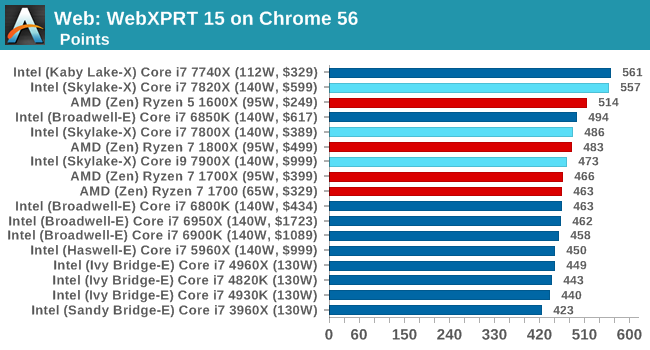The Intel Skylake-X Review: Core i9 7900X, i7 7820X and i7 7800X Tested
by Ian Cutress on June 19, 2017 9:01 AM ESTBenchmarking Performance: CPU Web Tests
One of the issues when running web-based tests is the nature of modern browsers to automatically install updates. This means any sustained period of benchmarking will invariably fall foul of the 'it's updated beyond the state of comparison' rule, especially when browsers will update if you give them half a second to think about it. Despite this, we were able to find a series of commands to create an un-updatable version of Chrome 56 for our 2017 test suite. While this means we might not be on the bleeding edge of the latest browser, it makes the scores between CPUs comparable.
SunSpider 1.0.2
The oldest web-based benchmark in this portion of our test is SunSpider. This is a very basic javascript algorithm tool, and ends up being more a measure of IPC and latency than anything else, with most high-performance CPUs scoring around about the same. The basic test is looped 10 times and the average taken. We run the basic test 4 times.

Sunspider goes after peak frequency most of the time, althoguh there is some variation as it moves into basically becoming a legacy test.
Mozilla Kraken 1.1
Kraken is another Javascript based benchmark, using the same test harness as SunSpider, but focusing on more stringent real-world use cases and libraries, such as audio processing and image filters. Again, the basic test is looped ten times, and we run the basic test four times.

Kraken is more of an intense attack on JS, and still regularly sorts by IPC and frequency.
Google Octane 2.0
Along with Mozilla, as Google is a major browser developer, having peak JS performance is typically a critical asset when comparing against the other OS developers. In the same way that SunSpider is a very early JS benchmark, and Kraken is a bit newer, Octane aims to be more relevant to real workloads, especially in power constrained devices such as smartphones and tablets.

Octane seems to be an optimization target, and with the new Skylake-X it shows.
WebXPRT 2015
While the previous three benchmarks do calculations in the background and represent a score, WebXPRT is designed to be a better interpretation of visual workloads that a professional user might have, such as browser based applications, graphing, image editing, sort/analysis, scientific analysis and financial tools.











264 Comments
View All Comments
Einy0 - Monday, June 19, 2017 - link
Ian, I stand corrected and apologize. I think I allowed a previous poster's anger affect my thoughts on the subject. I'm still very confused as to why you would not publish results on both platforms while including a note in regards to gaming performance. Not that these chips are for gaming but many of us use our PCs as an all purpose computing platform and gaming is frequently included in the mix.Ryan Smith - Monday, June 19, 2017 - link
"I'm still very confused as to why you would not publish results on both platforms while including a note in regards to gaming performance. "1) Lack of time. The most recent BIOS update came close to the launch, and we haven't yet had enough time to fully validate all of our data.
2) Right now gaming performance is all over the place. And with Intel doing pre-orders, by the time you got your chips there's a good chance there will be another BIOS revision that significantly alters gaming performance.
Gothmoth - Tuesday, June 20, 2017 - link
the whole article feels rushed to be honest.there is basically no talk about the insane powerdraw and temps when overclocked.
jardows2 - Monday, June 19, 2017 - link
Let me give you the conclusion ahead of time. If you are buying a gaming chip, buy the i7-7700K.These are not gaming chips, they are work chips that can do gaming. It's like buying a 1-ton diesel truck, and wanting to floor it at the stoplight. It'll do it, but a Mustang or Camaro will do that better. The truck will be able to haul pretty much anything, that the pony cars will blow their transmissions on.
Ryzen, on the other hand, is all AMD has, and so gaming results are very relevant to the discussion.
prophet001 - Monday, June 19, 2017 - link
^ ThisHurr Durr - Monday, June 19, 2017 - link
I`d rather wait for the next iteration, whatever Lake that was. Hopefully 6 cores will step down into the mainstream, and then there is 10 nm.koomba - Thursday, July 6, 2017 - link
How.many.times.does.it.have.to.be.said? They did NOT post gaming benchmarks on their first Ryzen review either! You are seriously at least the 10th person who has come on here spouting this COMPLETE falsehood, and using it to bash this site or claim some kind of bias.Please do some research before you just talk nonsense and base your entire argument around something that isn't true.
Gasaraki88 - Monday, June 19, 2017 - link
Thank you for this article. I knew I could count on Anandtech to write a detailed article on the new Intel cpus, how everything on them worked, like the caches and turbo core 3.0, etc. not just benches.marcis_mk - Monday, June 19, 2017 - link
Ryzen R7 1700 has 24 pci-e lanes (20 for PCI-E dGPU and 4 for storage)Ian Cutress - Tuesday, June 20, 2017 - link
AMD has a tendency to quote the sum of all PCIe. We specifically state the PCIe root complex based lanes for GPUs. Ryzen has 16 + 4 + 4 - root complex, chipset, IO. Threadripper has 60 + 4: root complex(es) and chipset. Skylake-S has 16 + 4 - root complex, DMI/chipset. Etc.